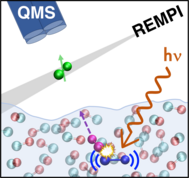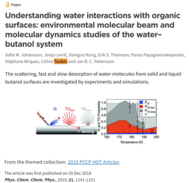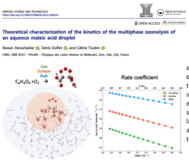Methodologies to model gas/particle interface reactions and bulk properties
The PCMT team has strong research focuses in both atmospheric chemistry and astrophysics. For both areas, the primary objective is to simulate molecular interactions within controlled environments. This is achieved through a combination of theoretical models and experimental validation to investigate key phenomena such as adsorption, photodissociation, and the formation of complex organic molecules. The simulations aim to deepen the understanding of molecular processes that are fundamental to both atmospheric and astrophysical environments.
Various methodologies, including classical MD, AIMD, DFT, DFTB, TDDFT, QM/MM, FDE, REAXFF, and AI-based NNPES, probe gas/particle interfaces. A collaboration with the University of the Basque Country has developed a GNOF-AIMD method for studying the N(4S) + H2(1Σ) → NH(3Σ) + H(2S) reaction (HAL: hal-04491144v1).
Structural and dynamical properties from ab initio and classical molecular dynamics
AIMD, utilizing DFT, is particularly effective for studying gas-surface interactions by computing energies and forces "on the fly." This approach, essential for complex reactive systems, has been applied in PhD research on photodesorption in CO ices (PhD S. Del Fré, See PCMT Highlight) and NO oxidation on oxidized graphite (PhD G. Alou, HAL: hal-04629324). AIMD's high cost limits its application to small systems or short timescales. For larger systems and longer simulations, force fields are used. Research by A. Roose (HAL: hal-02083941v1), J. Lovric (HAL: hal-02002428v1), and R. Abouhaidar (HAL: hal-04322632v1) has demonstrated the effectiveness of these models in atmospheric studies (See PCMT highlight for further details). New force fields for radionuclides, developed in collaboration with M. Masella from CEA, include polarization and charge-transfer terms and are crucial for accurate modeling (HAL: hal-03726342v1, HAL: hal-03360947v1).
In radionuclide separation, precise classical and polarizable force fields have been developed for studying alkane and monoamide solutions, with simulation data matching experimental results (PhD A. Failali, HAL: hal-03481112v1; PhD E. Acher, HAL: hal-02189107v1).
Classical MD combined with DFT has replicated experimental trends in Cl core binding energies (HAL: hal-03500186v2).
Properties and reactivity with hybrid QM/QM or QM/MM methods
For systems where classical MD and AIMD are insufficient, hybrid QM/MM methods (e.g., ONIOM) and QM/QM’ approaches have been used in both atmospheric and astrophysical contexts:
- The determination of accurate binding energies of atoms and small molecules (HAL: hal-03245237v1), which is of utmost importance since these quantities are often poorly known, which can affect interstellar surface reaction models, as outlined in a review paper (HAL: hal-03579914v1).
- The reactivity of H2 with formaldehyde at the surface of crystalline and amorphous interstellar ices (HAL: hal-03614163v1)
- The ozonolysis of maleic acid at the surface and diluted in aerosol water droplets (HAL: hal-04322632v1). Due to low barriers, the evaluation of reaction rate constants required to go beyond the usual transition state theory and includes both variational and multi-dimensional tunnelling effects, which is challenging when the number of degrees of freedom increases. In agreement with predictions of chemical models, the reactivity is shown to occur in the bulk rather than at the surface. Further insight on the next steps of the reaction (formation of Criegge intermediates) is currently under investigation using AIMD, which provides a complementary view introducing thermal and vibrational energies.
- Additionally, classical MD and DFTB have accurately modeled PAH adsorption effects on ice surfaces (HAL: hal-02447448v1).



